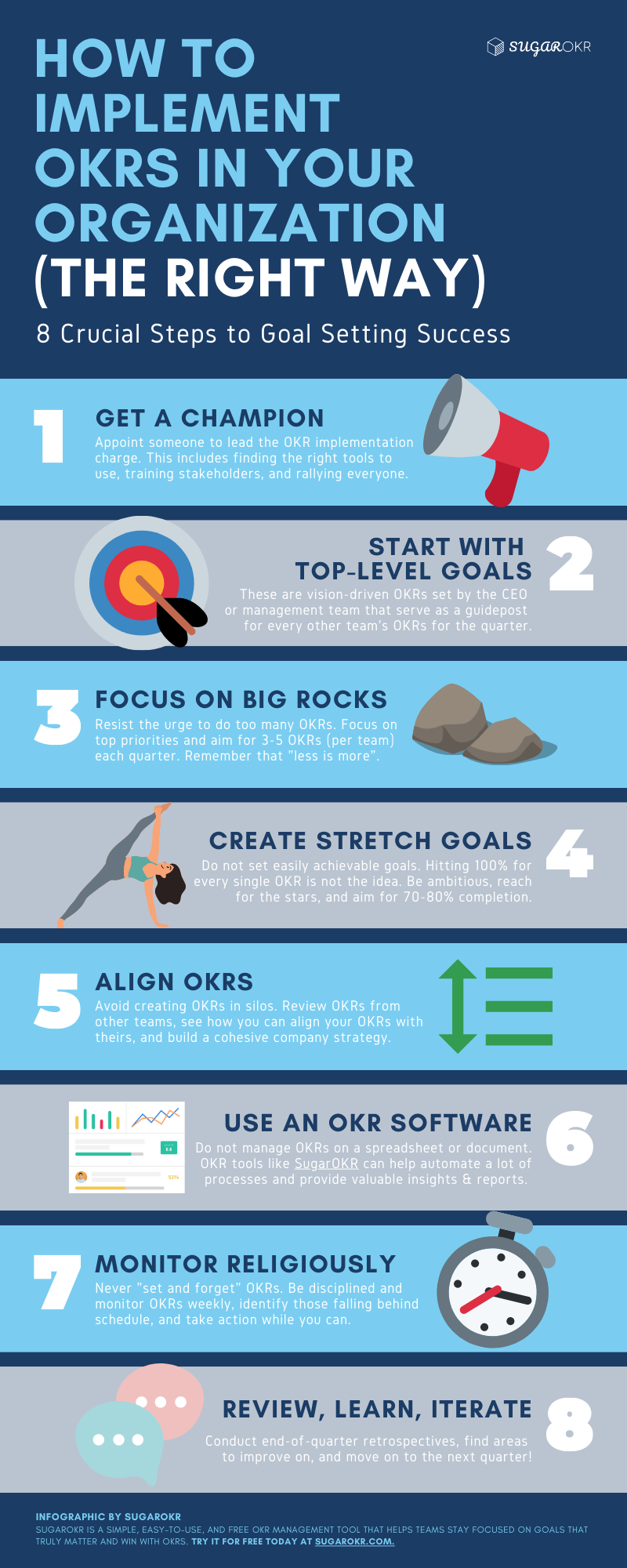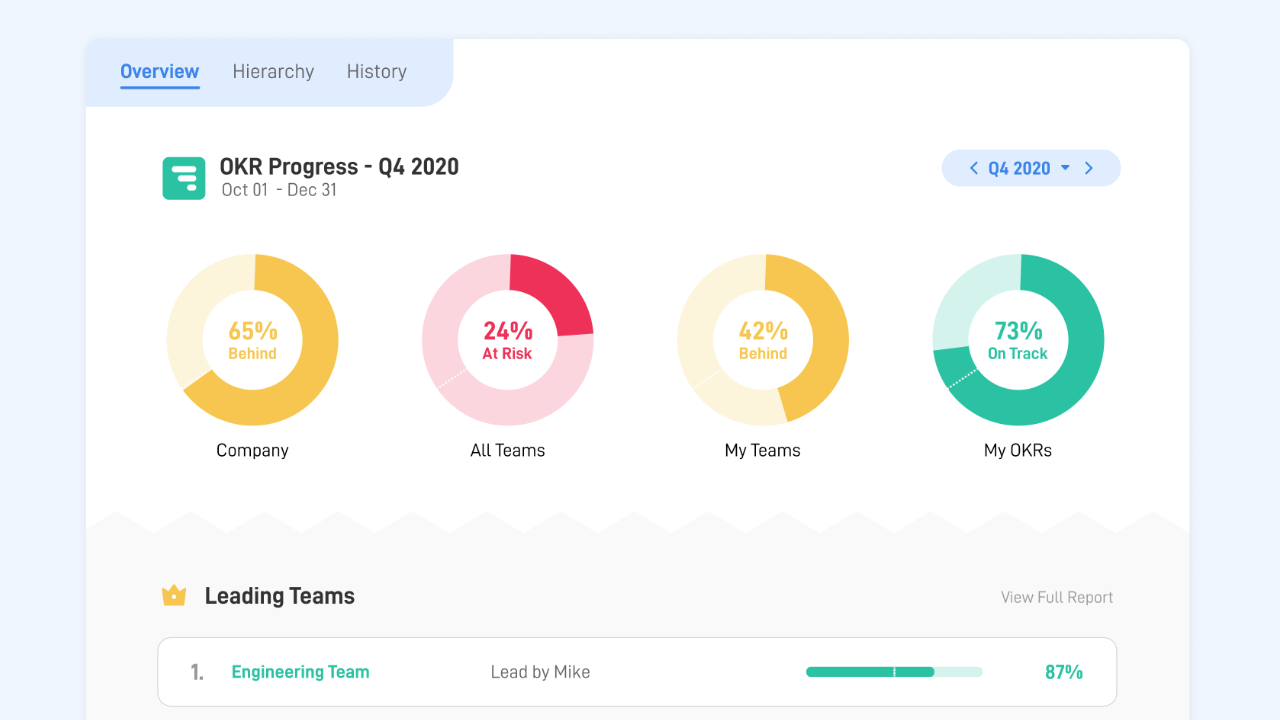People these days tend to have a love-hate relationship with OKRs. They see how OKRs can be beneficial to their organisation, yet few actually know how to implement OKRs correctly. Implementing OKRs is not as simple as most people think. Improper understanding of the OKR implementation process will only result in significant time, energy and resources lost.
This beginner’s guide will hopefully get you started on the right track – what OKRs are about, how to plan OKRs, and ultimately win with OKRs. There are a ton of other great resources online that go into greater detail that you should also check out separately in your own time.
Also, if you’ve recently signed up to use SugarOKR, congratulations! You’re now one step closer to getting your teams super focused on goals that truly matter, and winning with OKRs. If you have yet to sign up, you can try it for free by heading over to our website.
If you’d like to skip the read and head straight to a nice summary of the points in this article, check out the infographic.
For now, let’s get started with the basics. If you’re already very familiar with what OKRs are about, you can skip to section 2.
1) Introduction to OKRs
OKRs stand for “Objectives & Key Results”. It is one of the most popular goal setting methodologies that was made famous by John Doerr when he introduced it to Google in 1999. The concept soon spread across the world and is now the most widely used framework for organizations to plan, track and manage goals effectively.

John Doerr – just your regular John Doe who actually does stuff
In today’s world, different teams/functions/departments within an organization often fall into the “silo trap” – working on things that not only suck up valuable time and resources, but are not even aligned to the larger goals and vision of the company.
OKRs solve this problem because the framework forces teams to think big, collaborate, and work towards goals that truly matter to the organization. It builds transparency and accountability amongst co-workers, and moves everyone in the same direction. Now before we dive into how to implement OKRs correctly, let’s first understand what they are.
So what exactly are “Objectives” and “Key Results”?
Objectives
Objectives are big “qualitative” goals. They typically do not have a number attached to them and are written in a way that provides motivation.
Examples of Objectives could be:
- “Break into the US market”
- “Build a kick-ass Sales team”
- “Launch our new premium product line”
- “Improve our data security infrastructure”
- “Raise Series B funding”
Key Results
Key Results on the other hand are specific, measurable, and time-bound metrics. They typically have a number attached to them, as well as a specific time frame to achieve them.
Examples of Key Results (using the Objective examples above) could be:
- Break into the US market
Key Result: “Sign the lease of our 1st US office in New York”
- Build a kick-ass Sales team
Key Result: Hire 3 Sales Reps, each with more than 5 years of sales experience
- Launch our new premium product line
Key Result: “Get 500 signups on our pre-launch wait list”
- Improve our data security infrastructure
Key Result: “Test out 3 different software packages from security vendors”
- Raise Series B funding
Key Result: “Pitch to 7 venture capitalists with our new investment deck”
You can think of Objectives as the final destination, and Key Results as the check points that get you there. The more check points you cover, the closer you get to your destination.
Note: If you need to see more templates and samples, you can check out this compilation of OKR examples we put together.
Time frame
In project management, there are many time frames (windows) one can work with. It really depends on the scope and situation. Some teams work on a 6 month time frame, some 3 months (quarterly), some monthly, and some even weekly (e.g. weekly sprints).
OKRs are generally conducted in quarterly cycles. Why? Simply put, 3 months is long enough for meaningful work to be done, yet short enough to “course correct” if necessary. Public companies on stock exchanges also report their earnings on a quarterly basis.
This is NOT to say you should ditch your weekly sprints. They can still be used to support the larger OKR framework if you think it helps.
2) Planning out OKRs
Now that you get the gist of what OKRs are about. Let’s talk about how you should go about planning OKRs. It’s extremely crucial to take some time to plan things out properly first before diving in. Mistakes and do-overs are costly and frustrating.
Get a champion
OKRs are only as effective as how the organization makes it to be. People are generally resistant to change and implementing OKRs as a new framework could be daunting.
The key to getting started right is to have at least one champion to lead the charge. This could be the CEO, department head or team leader. This person needs to have a strong understanding of the OKR framework and have influence within the organization. It doesn’t matter if this person doesn’t (yet) know how to implement OKRs within the organization. That’s what guides like this are for – getting champions up to speed.

Michael Scott was always very accommodating
The next step is for this champion to rally the team leaders (managers) and get buy-in. Team leaders are the glue to everything. They are the ones who will be evangelising the OKR framework to their teammates, guiding them on how to plan their OKRs, and reviewing the progress each and every step of the way. In other words, team leaders not only need to know how to implement OKRs for their teams, they need to be on 100% board for everything else to work smoothly.
Once the champion and team leaders are aligned, an all-hands meeting should be held for everyone to know what the plan is. The champion should be leading this meeting. The goal is to get everyone excited about the benefits that the OKR framework will soon bring.
Start from the top
During the initial planning of OKRs, one of the biggest mistakes organizations make is having teams set their own OKRs in silos without communicating with each other. OKRs should ideally start from the top – where the CEO or senior managers get together a few weeks before the start of the new quarter and plan the company-level goals. Now this makes perfect sense because senior leaders typically know the larger vision of the company and where things should be heading. Once the top-level OKRs are established, the various departments or teams can use that as a guidepost to plan their OKRs. A proper OKR planning timeline and schedule should be established prior so there are no delays.
Of course this may be difficult in larger companies. If you are in a thousand man company, it may be impossible to get your CEO along with the entire organization to implement OKRs straight away. In such cases, the department or team leader should play the role of the “CEO” and set the top-level OKRs for the rest to follow (assuming they know what the larger goals of the company are).
Bottom line: Whether you’re operating at a company-level, department-level or team-level, always establish a top-level OKR (that is aligned with the larger vision) first, then get everyone else to plan their OKRs to support that.
Structure OKRs
The OKR framework has been around for some time and different companies have implemented it in different ways. Ideally the OKR structure would look something like this:
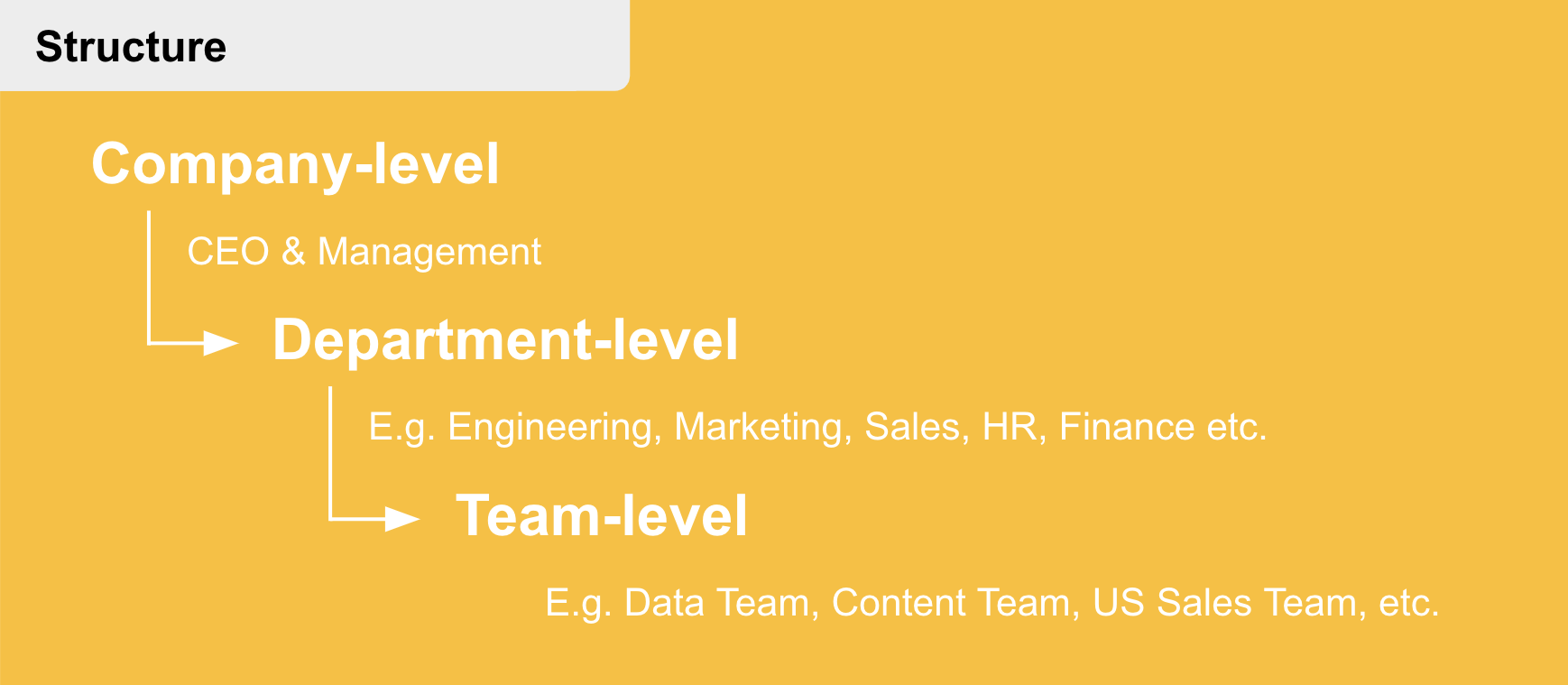
Every Objective or Key Result at any level will have one owner. Company-level OKRs are typically owned by the CEO or C-level executives. Team-level Objectives should be owned by the team leader who will oversee the progress of all the underlying Key Results (that are typically owned by his/her direct reports).
Now department-level OKRs obviously work more for larger organizations where a department is big enough to have a sub-teams within it. Smaller companies (e.g. less than 50 employees) probably don’t even have departments (i.e. the 5 person Marketing team is the Marketing department). In SugarOKR, we have made assigning departments entirely optional.
You’ll also notice that personal OKRs (below the team-level) are missing here. Personal OKRs are OKRs that are not tied to any team. They operate entirely at the individual’s level. Now there are different views around this and people have been debating about this for some time. Should employees have personal OKRs?
Here at SugarOKR, we are of the view that personal OKRs are not necessary (or even recommended) in the framework. The reason is simple: OKRs should align themselves (directly or indirectly) to the larger goals of the organization. Otherwise, they just exist as another person’s task list.
Think about it this way: Tom the CEO doesn’t care what Bob the designer is doing at an individual level. He does, however, care what Bob is doing for the Design team – the team that is helping the Marketing team hit its Objective “Launch a brand awareness campaign”; which so happens to be a campaign that is instrumental to helping Tom hit his Objective “Extend consumer reach in Europe”. Get it?
The only exception to this is if it’s a one-man team. In other words, if Bob is the only designer in the company. He’s also the team leader, owns the main Objective, as well as all the underlying Key Results. That becomes his “personal” OKR.
That being said, if someone still wishes to create personal OKRs to support the “official” OKRs they own (and are visible to everyone in the organization), they can do so separately if they think it helps them (so long as they are still part of a team). There is really no hard and fast rule.
3) Winning with OKRs
You’ve got a champion to lead the charge, and buy-in from everyone. You’ve also structured your organization in a way that makes sense. You’re now ready to actually start creating OKRs. How should you go about doing it so that you’re set up for success?
Set realistic “stretch” goals
OKR performance is measured by percentage or a score from 0.0 – 1.0. The score is simply the numerical version of the percentage rounded to one decimal place. For example, if the progress of an Objective is 78%, the score is 0.8. If the progress is 32%, the score is 0.3%.

It’s important to note that winning with OKRs is not about hitting 100% (or a score of 1.0) every single time for every single OKR. In fact, doing so only shows that your OKRs are too easy. This will not help move a company to greater heights.
As mentioned earlier, OKRs are big goals. They should hence ideally be “stretch goals” – goals that are slightly more difficult (but not impossible) to achieve. Setting and planning for stretch goals does exactly what it implies: it stretches the company to newer and greater heights.
So create stretch goals with an aim to hit a score of at least 0.7 (70%) each time.
Note: While the above mentioned stretch goals are “aspirational OKRs”, there is another type called “committed OKRs” that do actually require owners to hit 100% (OKR score of 1.0). Read more about aspirational vs committed OKRs here.
Remember: Less is more
OKRs act as an amazing forcing function to get teams focused on goals that matter and make an impact to the larger goals of the organization. Despite that, it’s still common (and tempting) for teams and individuals to want to do more than necessary to “cover ground”. This is dangerous because if everything is a priority, nothing is a priority.
While there is no magic number for exactly how many Objectives and Key Results each team should have at any given quarter, the general consensus is: 3-5 Objectives, with each Objective having 3-5 Key Results.
The reason behind this recommended range is this: if a team is planning for 3 Objectives, each with say 4 Key Results, the team essentially has only 12 weeks to complete 12 Key Results for the quarter. That translates to accomplishing one Key Result per week. While that may be possible for some people in some scenarios, always default the golden rule for OKRs: less is more. Lesser Key Results forces people to really trim the fat and focus on the big rocks. You’d rather do well in a few things than terribly in many things.

#mindblown
In any case, always use good judgement to determine what the right number of OKRs should be, given your available resources.
Align OKRs across teams
There’s one little tactic that many companies adopting OKRs do not use (or are even completely unaware of) – that is “linking” OKRs together.
If an Objective directly impacts another Objective, it helps to link (align) them together. Aligning organizational goals are extremely beneficial as it helps motivate and move everyone quicker and more efficiently towards the company’s vision.
Here’s an example of how OKR alignment could go about happening.
The Content team has the following OKR:

The Demand Generation Team has the following OKR:

Now during the planning phase, the Content team leader may realise that producing great content like thought-leadership articles and infographics actually helps bring in more top-of-funnel leads to the website, and increases conversions. The content can also be used by resellers when educating potential clients and prospects.
In other words, the Content team’s Objective “Launch a content campaign to increase awareness” directly impacts the Demand Generation department’s Objective to “Build a strong lead generation pipeline”.
Linking the 2 to show how these 2 OKRs are aligned will end up looking something like this:
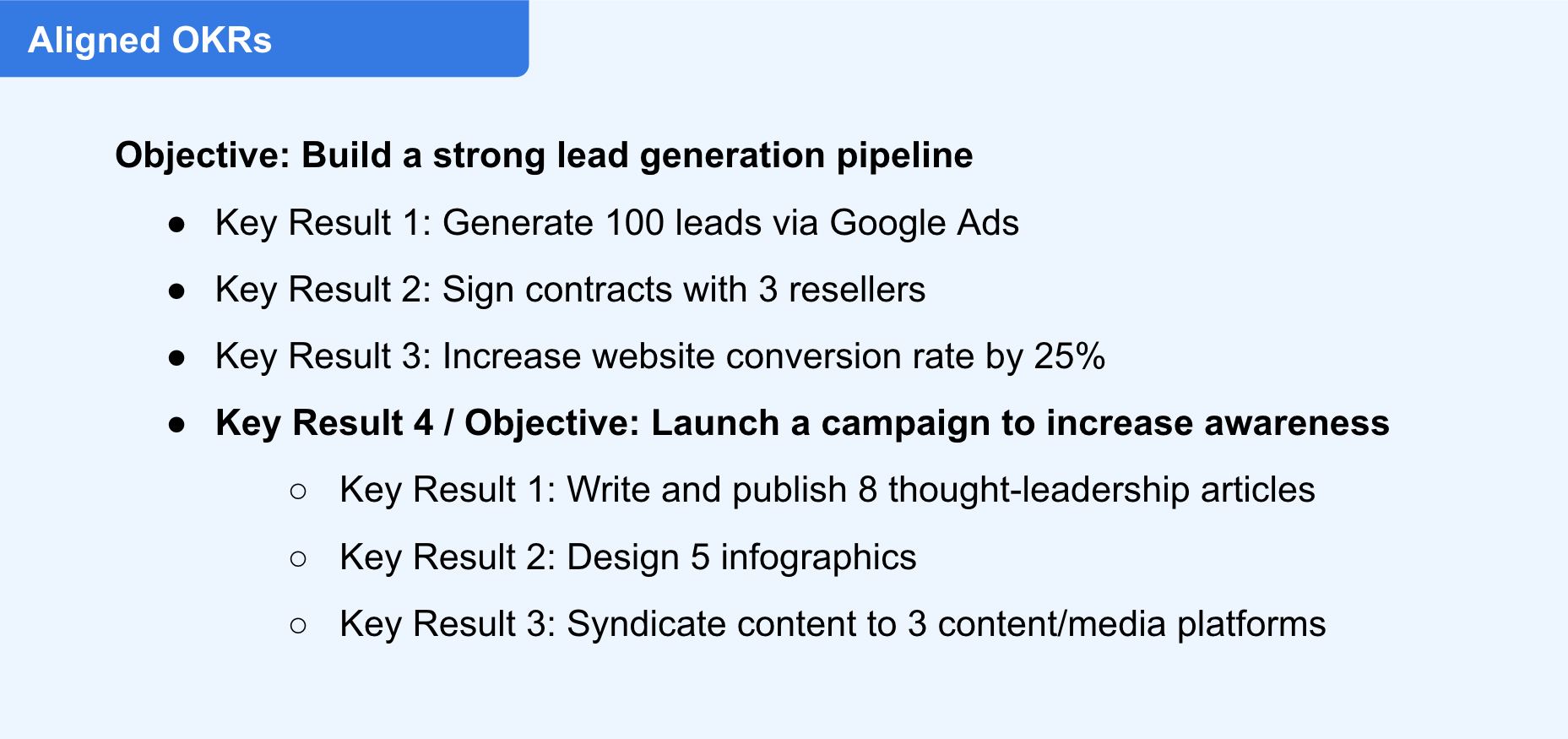
Can you see what’s happening? The content team’s Objective now plays a dual role: (1) a Key Result to the new parent Objective, and (2) an Objective to the original Key Results.

Teams can keep linking OKRs together and before you know it, an organization will have many “chains” of OKRs linking together, right up to the top-level OKRs. The SugarOKR platform allows anyone to visualize this easily via an OKR hierarchy view.
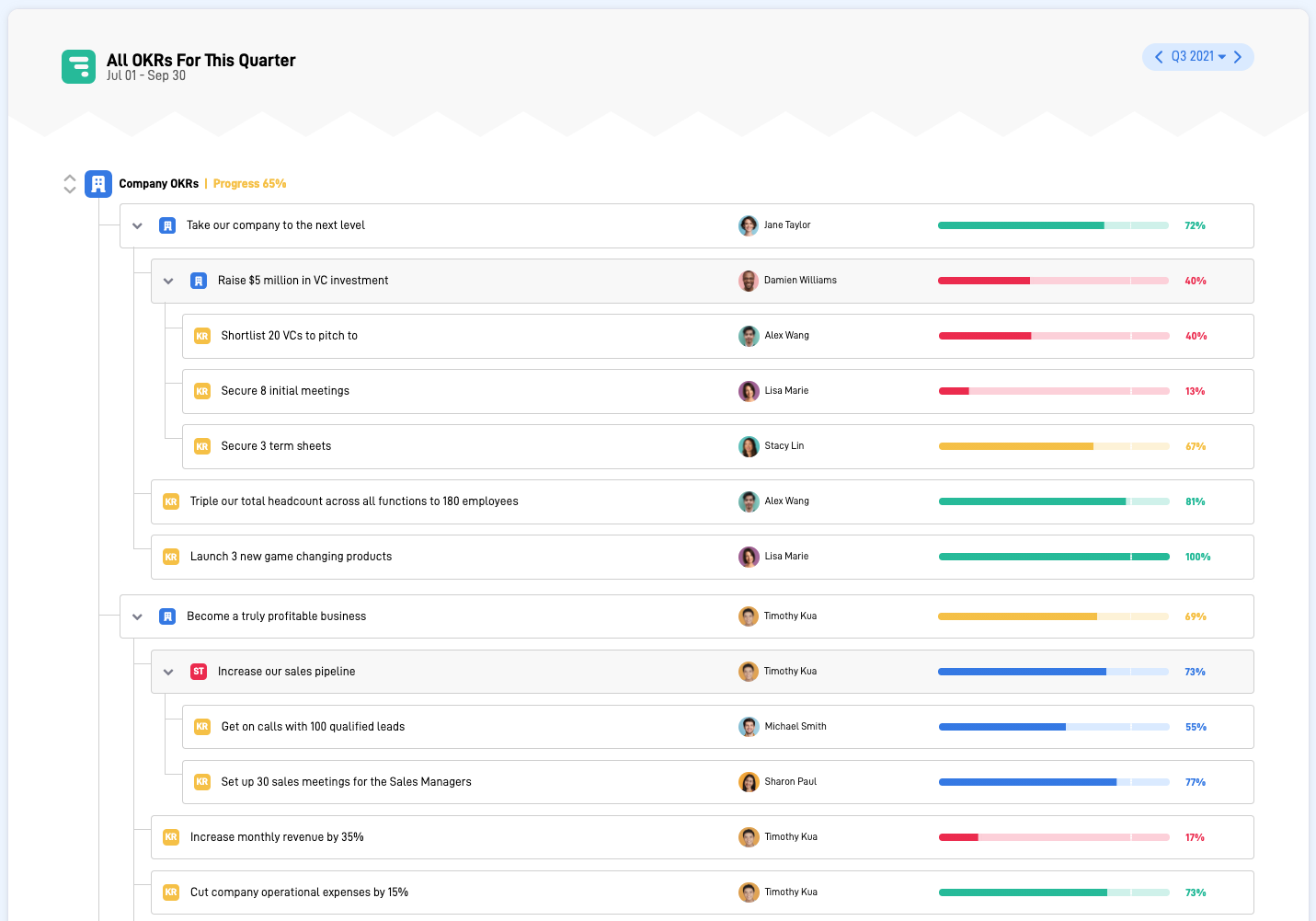
Screenshot of a hierarchy breakdown in SugarOKR
This is extremely powerful as it allows everyone to visually see how their work fits in the whole picture. People start to realise why what they’re doing matters, and get even more motivated to work on them. A junior manager working on a seemingly unimportant task could in fact, be indirectly helping the company hit its most important Objective for the quarter!
Note: Not every Objective needs to link/align with another. Very often, it just stands alone and that’s perfectly fine.
Use an OKR software/tool
One of the biggest mistakes organizations make when implementing OKRs, is not utilizing a proper software or tool to manage them. They may have done all the research, planned everything out well, and got the entire company fired up to start adopting the OKR framework; but when it comes down to the tool of choice, they end up using spreadsheets and documents to manage their OKRs.
It’s easy to understand why spreadsheets and documents seem to be the first place people go to manage their OKRs. It’s easy to get started on, doesn’t incur additional cost, and something they may already be using everyday to collaborate on.
The problem with this primitive method is that it doesn’t automate processes (that you’ll later realize you need to do a lot of manually), and it doesn’t give you all the proper insights and analysis of how your OKRs are doing. You end up not extracting the true value that OKRs are supposed to provide.
Proper software and tools help automate a lot of the process and more: from weekly email/Slack check-in reminders and alerts on OKRs at risk, to recommendations and regular reports on how every team and individual is progressing. Data can be sliced and diced at a snap to help managers visualize every aspect of the business: Which projects are falling behind? Which are the best performing teams? Who are the superstars? What is the overall progress of the entire company?
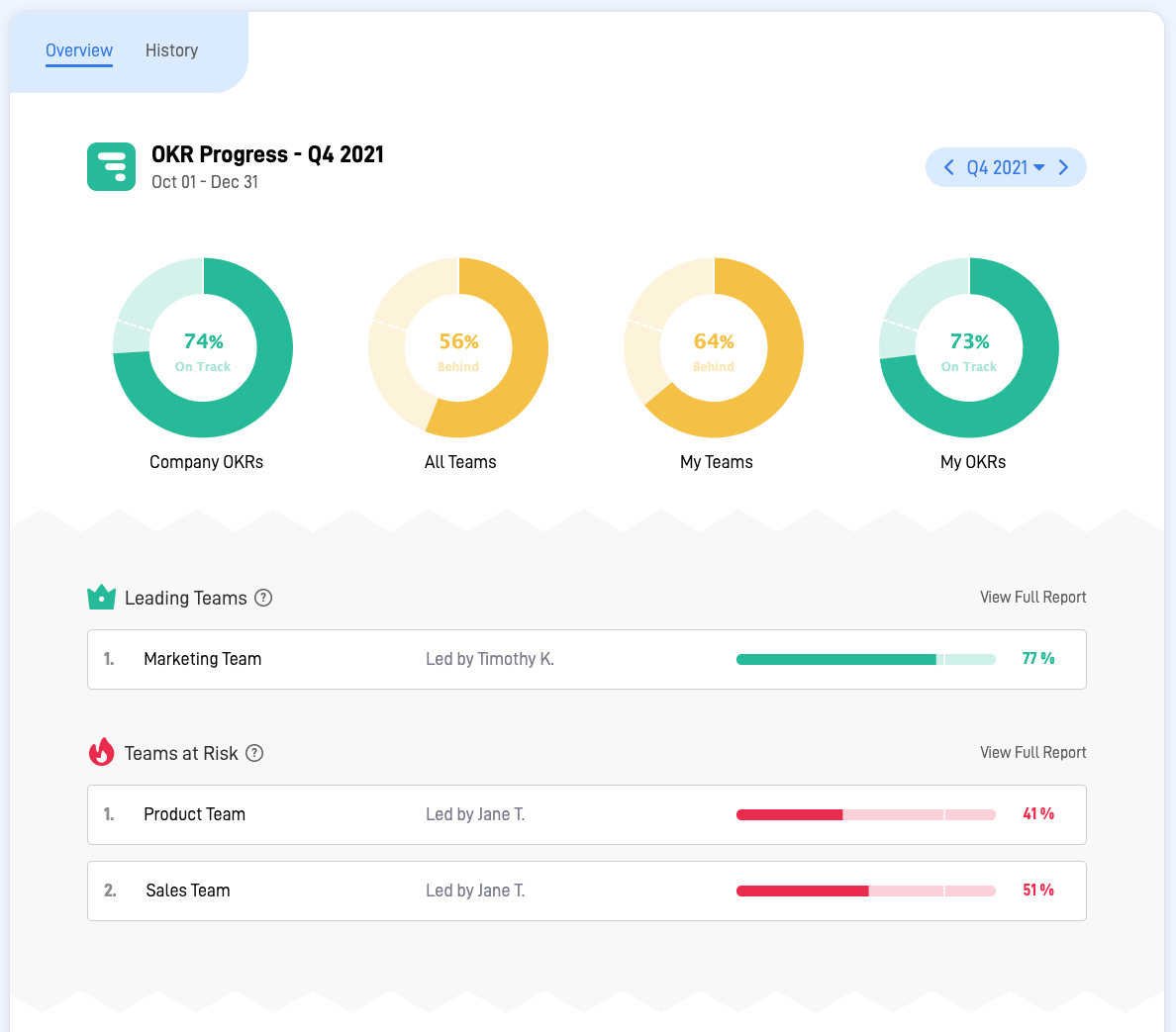
Screenshot of the SugarOKR dashboard
Thankfully, at this day and age, it’s easy to find and implement OKR software and tools. If you’re in a larger company and are already on some HR or productivity software (e.g. Asana or Monday.com), there should already be OKR “modules” you can easily add on to your existing suite.
If you’re a startup or a smaller company wanting something simpler, lighter, and cost-effective (even free), then dedicated OKR platforms like SugarOKR and Weekdone are good options for you to get started on.
Review, learn, iterate
OKRs work best when there is full transparency within the organization. In other words, everyone should be able to see everyone’s OKRs. There should be no “secret OKRs”. Team leaders need to instil a culture of accountability amongst team members for the system to work. This means every single person needs to be constantly staying on top of their assigned Objectives or Key Results, and updating the progress of their OKRs on a weekly basis (minimum). SugarOKR helps with this further by automatically sending everyone weekly email reminders to check in on their OKRs.
Team meetings or one-on-one meetings should also be held on a weekly or bi-weekly basis to review everyone’s progress. This is extremely important because team leaders need to catch OKRs that are falling behind or at risk, and take action before it’s too late. “Setting and forgetting” is a sure-fire way to fail your OKRs.
During the final month of the quarter, team leaders should review everyone’s progress even more thoroughly, and start planning for the next quarter. There will be a lot to learn from every OKR cycle. Maybe you planned for too much (or too little). Maybe the larger vision of the company changed and you need to pivot.
Whatever the case, know that it’s a never-ending learning journey when it comes to OKRs, but teams will only get better and better at their OKRs over time.
Summary (Infographic!)
OKRs are a great and proven way for organizations to rally everyone together, keep teams hyper focused, and motivate individuals. It can be daunting at first, but it only gets easier (and better) over time. Finally, know that every company is different. While there is no “one size fits all” strategy for implementing OKRs, there are key guidelines you can follow to increase your odds of success. Hopefully this article has highlighted some of them and helped you understand how to implement OKRs for your company better.
Here are 8 takeaway points for your OKR implementation journey in a nice infographic. Feel free to share this with your team mates. Good luck!
Click image to expand
SugarOKR is a beautifully simple and easy-to-use free OKR management tool that helps teams unlock the full potential of OKRs, while staying focused and motivated. To find out how your company can win with OKRs, visit us at sugarokr.com.
